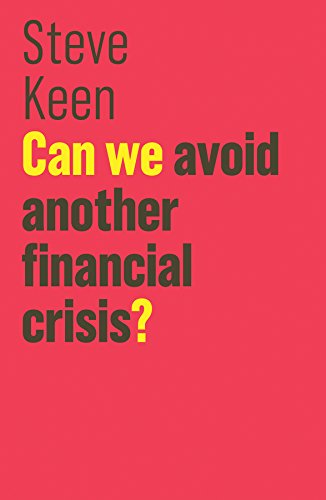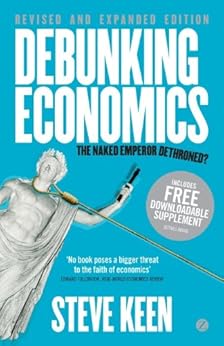My job as a self-employed telecoms network architect required a passing familiarity with microeconomics (traffic modelling, business cases). Sometimes I would delve into macro, my interest being in crises, recessions and the preconditions for a new wave of expansion. People only build big public networks in a time of exuberant growth.
Like Royston Vasey, the search proved elusive. Thanks to Steve Keen, I now know that orthodox macroeconomics simply assumes that crises cannot occur. Those that happen nevertheless cannot be structural, but are due to policy errors or 'outside shocks'.
Keen identifies the bizarre foundations of contemporary macroeconomic models as used by businesses, governments and international agencies: the modelling of all consumers as equivalent atomised individuals (no finance and industrial capitalists, no organised workers); the abstraction away of money, debt and the entire financial sector. A continual return to equilibrium is built in.
Taking these things into account, however, leads to very different models which show strong (and empirically-validated) correlations between excessive private debt and crashes; the economy exhibits chaotic rather than equilibrium-seeking behaviour, something like the weather.
This is all explained rather concisely in his latest book which I've now completed.
 |
| Amazon link |
I was rather impressed: his arguments seemed plausible and well-corroborated. In the UK he sees an unregulated finance sector (think Margaret Thatcher's 'Big Bang' reforms) as having opened the floodgates of private debt (he has supporting data) and thinks that the chronic UK Government deficit is really a symptom of the long post-crash malaise rather than the prior cause of it.
Reading his Wikipedia bio, I was only slightly surprised to read this:
"In August 2015, Keen endorsed Jeremy Corbyn's campaign in the Labour Party leadership election."
 |
| Amazon link |
I'll be checking out his main book (above) in the near future. Here's Steve Keen on the BBC's HardTalk.
The interviewer is pretty aggressive and it helps to have read Keen's "Can We Avoid Another Financial Crisis? (The Future of Capitalism)" to understand the logic of his responses.
Needless to say I am interested in the "Complex Systems Model" approach taken by Keen and others. There are several good talks and books by other Mathematical Economists in this area. One mathematical question is to determine *exactly* (ie mathematically) what has gone wrong in the "Economic Standard Model". I am pursuing a mathematical idea about this based on
ReplyDeleteissues connected with the foundations of logic and computation which were not known about at the time these models were developed. I agree that a paper or two on this is definitely called for.
On a (not entirely) unrelated matter I have found an interesting gap in some Resolution Completeness Proofs in connection with Herbrand's Theorem (no sign yet of anyone else noticing this despite my Google searches). However I have read that Robinson also did not like the existing proofs and developed a new one for his 1979 book called something like the "Herbrand Map Tree Argument". Unfortunately I dont have that book, so I dont know exactly what this proof is, or whether it avoids the issue I have uncovered.
Keen has done some maths and developed an open source computer model called Minsky.
Deletehttp://www.ideaeconomics.org/minsky/
If I cared a little more (who knows, I may) I would delve into this a little more deeply.
I haven't looked at the Herbrand stuff too closely but if you get any interesting results please let us know.
Yes, there is lot to study in both areas, but ideally one wants to find an inter-consistent and interesting overarching theory.
Delete1. Yes maybe I should download Minsky at some point and study this computer model, but I might want to clarify the mathematical theory first. There are interesting interconnections in this debate. Perhaps I will have to read some Keen before commenting further.
On Resolution I have made an interesting Internet discovery since my remark yesterday, so I shall outline some of it now.
The Stanford Logic Group have promoted "Herbrand Logic" to be contrasted with regular FOL. The core of the difference is in the semantics:
FOL : Tarski Semantics
Herbrand Logic : Herbrand Semantics (+ FOL Syntax)
Herbrand Logic obeys different Logic metatheorems compared to FOL. In particular
Herbrand Logic is non-compact ==
Herbrand Logic satisfiability is *not* semi-decidable
by contrast we have
FOL is compact = Satisfiability *is* semi-decidable.
I think there may be some confusion as to what "Herbrand's Theorem" exactly refers to (especially in the Resolution Literature). In the WP article we have a limited accurate theorem, but it is not the statement attributed to Herbrand in e.g. Robinson 1965
RH "If S is any finite set of clauses and H(S) its Herbrand Universe, then S is unsatisfiable if and only if some finite subset of H(S) is unsatisfiable."
This statement RH (which Robinson 1965 does not prove, but only refers to Putnam/Davis 1960, (which itself refers to Quine 1959) and who claim that it is the FOL Compactness Theorem) does indeed seem to be the Compactness Theorem. Thus Robinson here is using Herbrand theory (which should be non-compact) but using FOL's Compactness theorem which is contradictory.
The definitive Robinson answer will be in Robinson 1979, but I dont have that book, so I cannot tell if Robinson ever clarified this, but he may have suspected that something was wrong with his earlier arguments.
The Stanford group meanwhile say that Herbrand Logic is much more suitable than FOL for logical AI purposes like deductive databases, etc. They have an excellent set of slides on their approach too. Incidentally they also claim that the non-compactness in their system is amended by adding "Inductive Theorem Proving". Expressed in Resolution terms this would be that
1. Resolution itself is incomplete (pace Robinson)
2. Automatic Theorem Proving can be enhanced by Inductive Theorem proving, however.
(Specifically this would mean that your Chatbot would need an Inductive Theorem Prover as well as a Resolution Theorem component, to get really smart and chatty...)
Herbrand himself is often credited as the beginner of the theory of Logical AI, but he died within one year of his PhD, just as Godel's Incompleteness theorem appeared, and 5 years before Turing. Hence modern logicians have to "reinterpret" his work, but this reinterpretation might be biased towards FOL theorems rather than the theorems Herbrand might have produced if he had seen computation theory etc.
The good news is that these Stanford Herbrand Logic results provide a concrete example of some meta-theorems I have been developing. Perhap my paper could be called:
"How to Extend the NRS Chatbot by non-resolution principles."